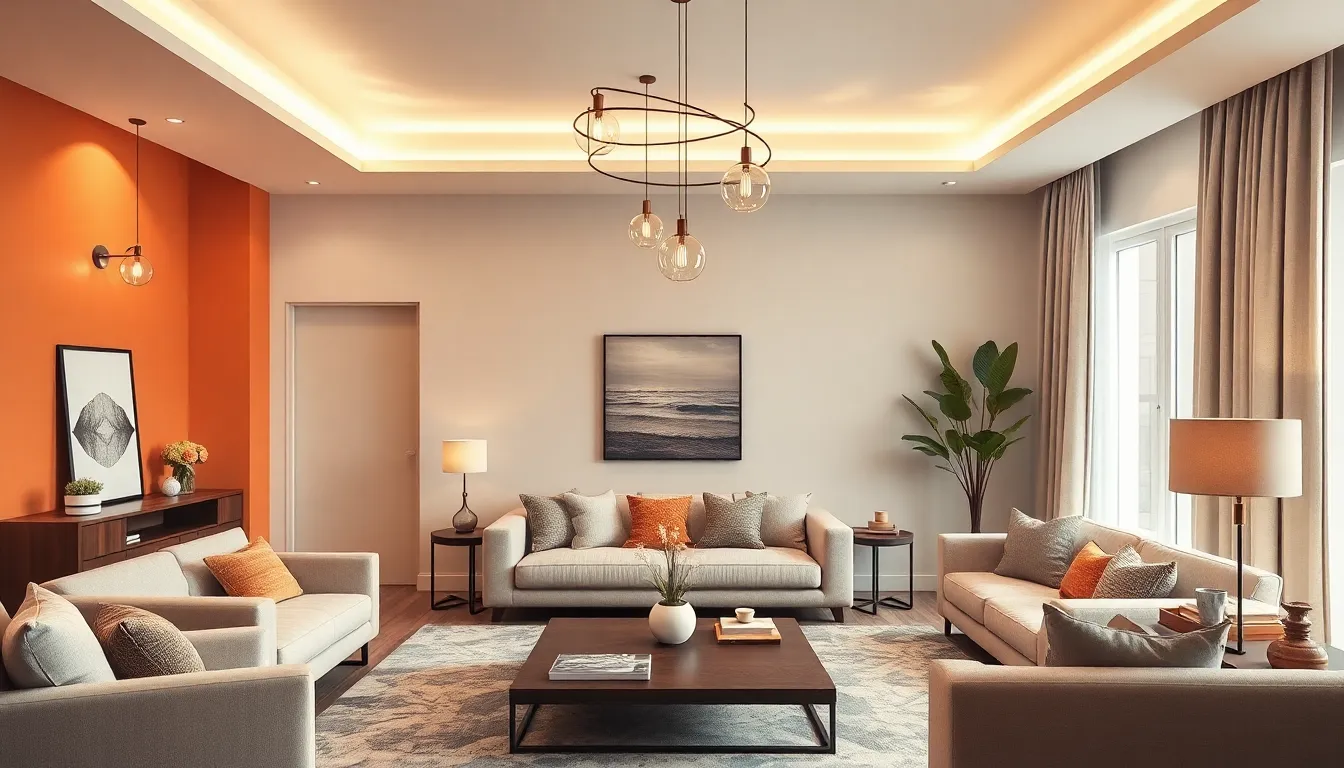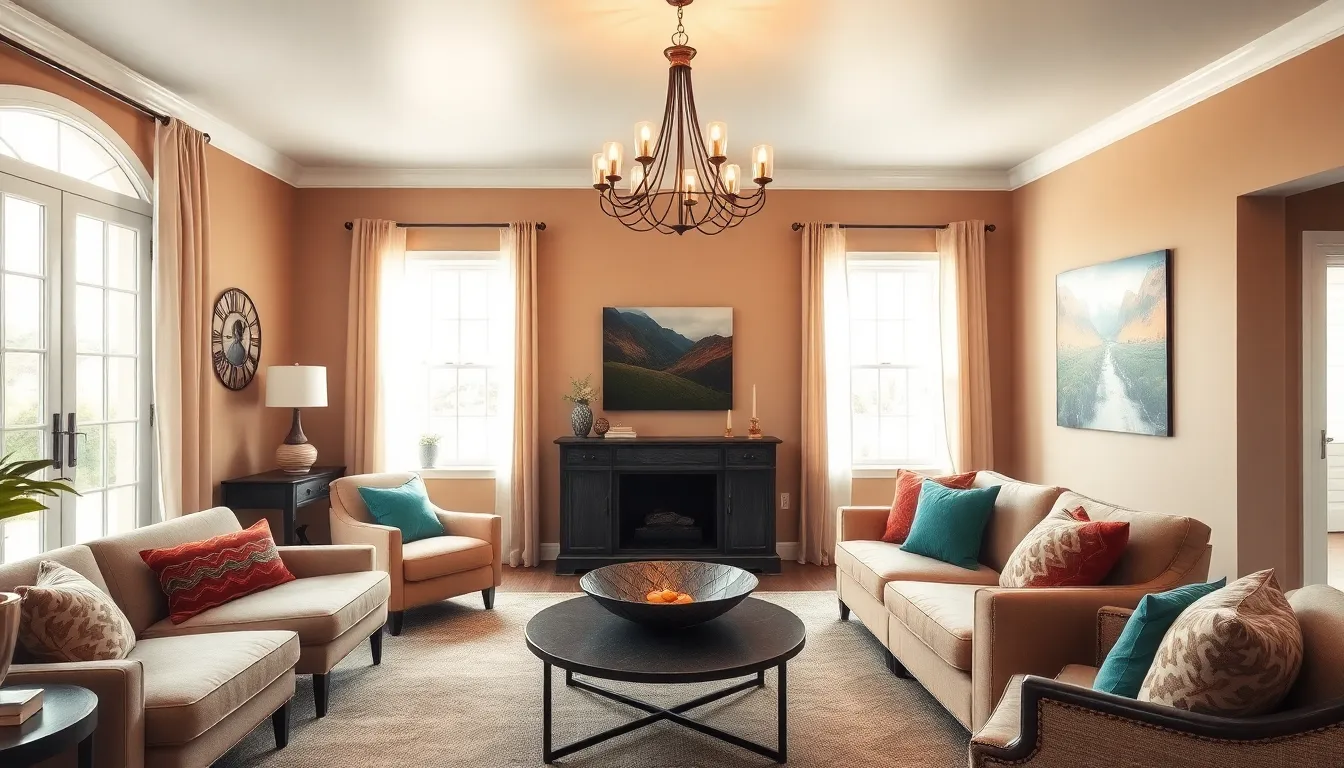Transforming a space from drab to fab isn’t just for reality TV shows. Interior decorating is an art that can turn any room into a sanctuary or a vibrant gathering spot. With the right touches, even the most uninspiring corners can burst with personality. Imagine walking into a room that reflects your unique style—it’s like a warm hug from your home.
But let’s face it, not everyone has an eye for design. Some might think that mixing patterns is a sport, while others treat paint colors like a high-stakes game of roulette. Fear not! This guide will navigate the whimsical world of interior decorating, making it accessible and fun. Whether you’re a seasoned pro or a total newbie, it’s time to unleash your inner designer and create spaces that make you smile every day.
Table of Contents
ToggleWhat Is Interior Decorating?
Interior decorating focuses on enhancing the aesthetics of indoor spaces. This practice involves selecting colors, furniture, lighting, textures, and accessories to create a cohesive and inviting environment. Decision-making plays a crucial role in the decorating process, as each choice contributes to the overall feel of a room.
Functionality also remains essential in interior decorating. A space can look beautiful yet serve its purpose efficiently. Proper layout, flow, and access to essential items ensure that decorated spaces invite comfort and utility.
Sourcing materials and furnishings often requires exploration of various options. Many decorators look for items that align with the homeowner’s personality, incorporating preferences that reflect those who use the space. By blending style with individual taste, decorators curate distinctive environments.
Learning about design principles proves beneficial for anyone interested in interior decorating. Elements like balance, contrast, and harmony can guide decisions, resulting in well-informed choices. Researching trends can inspire creativity while providing clarity on what works best for specific spaces.
Working with professionals can simplify the decorating journey as well. Interior designers bring expertise that can help navigate complex decisions. Collaboration often brings fresh perspectives, enhancing the final result and incorporating elements that might not have been considered otherwise.
Interior decorating combines creativity and practicality. By prioritizing aesthetics and functionality, it creates harmonious spaces. With a little guidance, anyone can transform their home into a reflection of their unique style and preferences.
Key Elements of Interior Decorating


Interior decorating revolves around several key elements that contribute to a harmonious space. Understanding these elements enhances the effectiveness of the decorating process.
Color Theory
Color theory plays a vital role in interior designing. Warm colors like red and yellow evoke energy, while cool colors like blue and green offer tranquility. Choosing a color palette sets the mood of the space. Neutrals provide flexibility, allowing for bold accents without overwhelming the decor. It’s important to assess how natural light interacts with colors throughout the day for an accurate appearance. Consistency across rooms fosters a cohesive flow, enhancing the overall aesthetic.
Furniture Selection
Selecting the right furniture influences both function and style. Comfort should remain a top priority; well-chosen pieces invite relaxation while serving their intended purpose. Scale matters significantly; proportional furniture complements room dimensions. Diverse styles can create visual interest, so mixing contemporary with vintage can yield unique results. Prioritize quality over quantity, as well-constructed pieces last longer and make a statement. Consider multi-functional options, especially in smaller spaces, to optimize utility without sacrificing design.
Lighting Design
Lighting design shapes the overall ambiance of any interior. Layering different types of lighting, such as ambient, task, and accent, creates depth and interest. Natural light is invaluable, enhancing mood and making spaces feel larger. Use decorative fixtures, such as pendants or chandeliers, to draw attention and elevate style. Dimmers provide versatility, allowing for adjustments based on activities and times of day. Thoughtfully placed lighting highlights key features, adding a sense of drama and elegance to the decor.
Popular Interior Decorating Styles
Interior decorating encompasses various styles, each with distinct characteristics and appeals. Understanding these styles enhances the ability to personalize spaces effectively.
Modern
Modern interior design emphasizes minimalism and clean lines. It features neutral color palettes, often complemented by bold accents. Furniture tends to be sleek and functional, prioritizing comfort without sacrificing style. Natural materials like wood and stone frequently appear, enhancing the aesthetic connection to nature. Open spaces characterizing modern designs promote airflow and light. Incorporating technology also plays a significant role, with integrated smart home features becoming increasingly popular.
Traditional
Traditional interior design draws inspiration from historical styles, creating warmth and elegance. Classic elements such as ornate furniture, rich color palettes, and intricate patterns define this style. Fabrics like silk and velvet are commonly used for drapes and upholstery, adding a luxurious touch. Rooms often showcase dark wood furnishings and antique accents to reinforce a timeless atmosphere. This style embraces symmetry and balance, further enhancing a sense of order. Subtle details, like crown molding and wainscoting, contribute to its refined appearance.
Bohemian
Bohemian interior decorating celebrates individuality and creativity. It features a mix of colors, textures, and patterns, creating an eclectic feel. Various textiles, such as tapestries and throw pillows, add depth and interest to spaces. Incorporating plants and natural elements fosters a relaxed atmosphere, making it feel inviting. Vintage and handmade items are common, showcasing personal history and global influences. Layering various design elements contributes to the unique and vibrant character of Bohemian spaces.
Tips for Successful Interior Decorating
Emphasize a clear vision before starting the decorating process. Define your style to streamline choices throughout the project.
Choose a color palette that resonates with your personality and sets the mood. Warm tones evoke energy while cool tones create a sense of calm.
Incorporate furniture that balances size, comfort, and functionality. Select pieces that complement the space and serve multiple purposes, particularly in smaller areas.
Layer lighting to enhance ambiance. Combine ambient, task, and accent lighting to add depth and variety.
Utilize textures and patterns to create visual interest. Mix smooth surfaces with soft fabrics for an inviting atmosphere.
Maintain balance through furniture arrangement. Position larger items opposite each other to create equilibrium in the space.
Acknowledge the significance of accessories. Use art, plants, and decorative items to personalize and elevate a room.
Incorporate natural elements for a refreshing look. Adding greenery or natural materials enhances the connection to nature.
Evaluate functionality alongside aesthetics. Ensure spaces remain practical and serve their intended purposes efficiently.
Seek inspiration from various interior design styles. Each style, whether modern, traditional, or Bohemian, offers unique elements to integrate into your home.
Utilize design principles like contrast and harmony. These guidelines can assist in making informed decorating choices.
Collaborate with professionals if the process feels overwhelming. Their expertise can provide fresh perspectives and simplify decisions.
Embracing interior decorating opens the door to transforming any space into a personal sanctuary. With the right guidance and understanding of design principles anyone can create an environment that resonates with their unique style. By focusing on elements like color, furniture, and lighting it’s possible to achieve both beauty and functionality.
The journey of decorating should be enjoyable and reflective of individual tastes. Whether opting for modern minimalism or a cozy traditional vibe the key lies in making choices that feel authentic. With creativity and a little planning anyone can craft a home that not only looks stunning but also feels like a true reflection of who they are.





